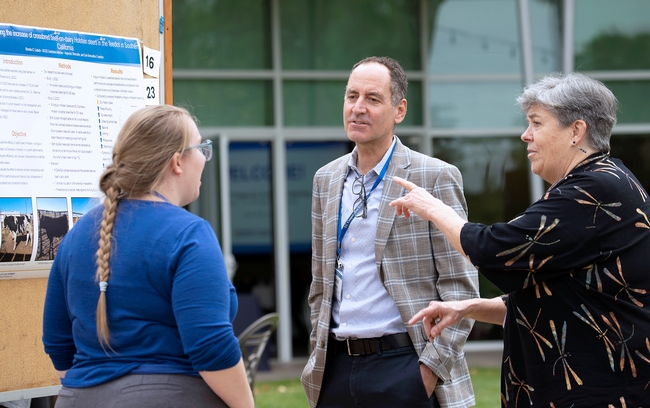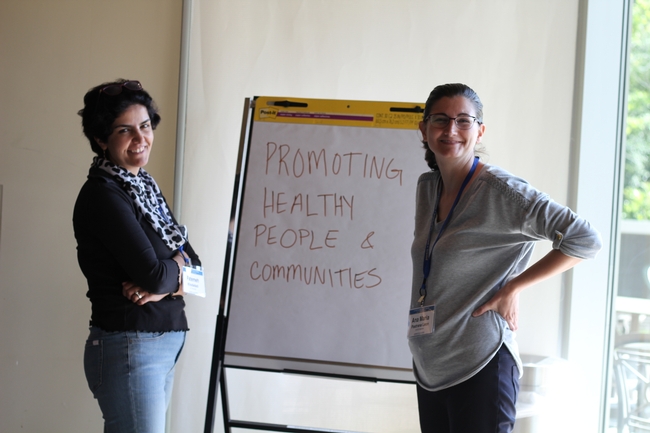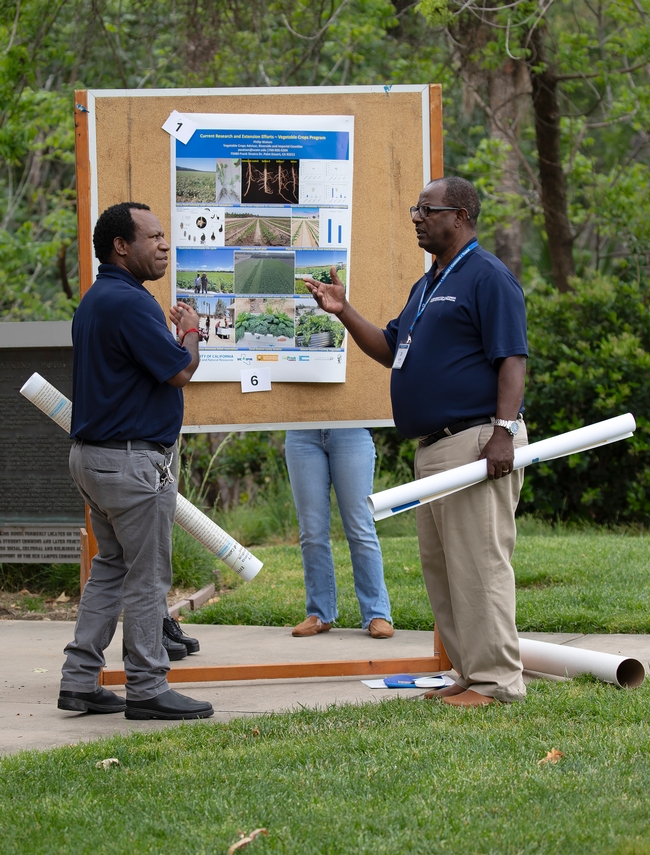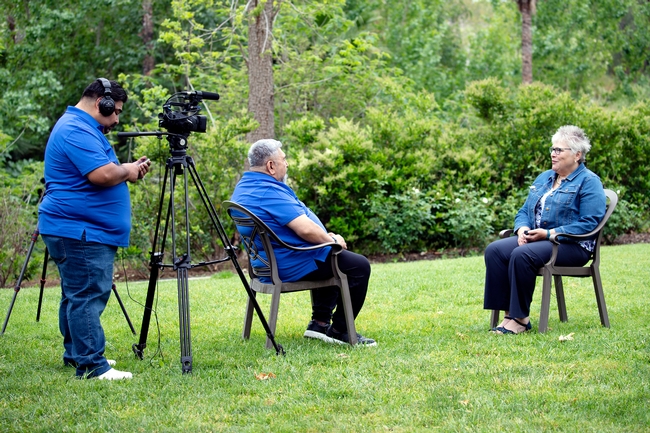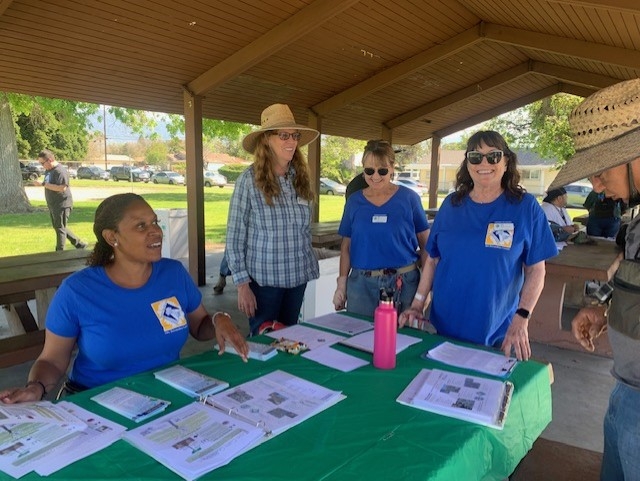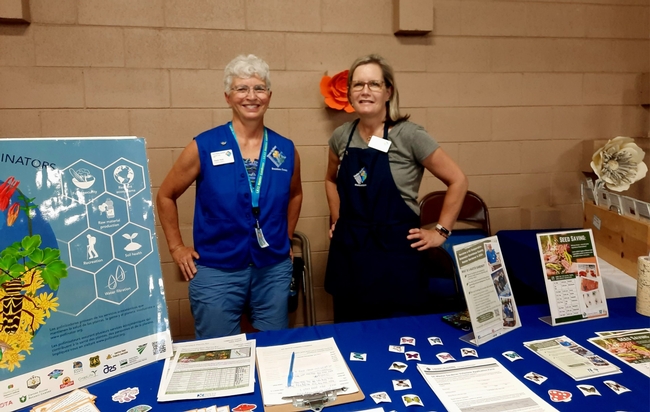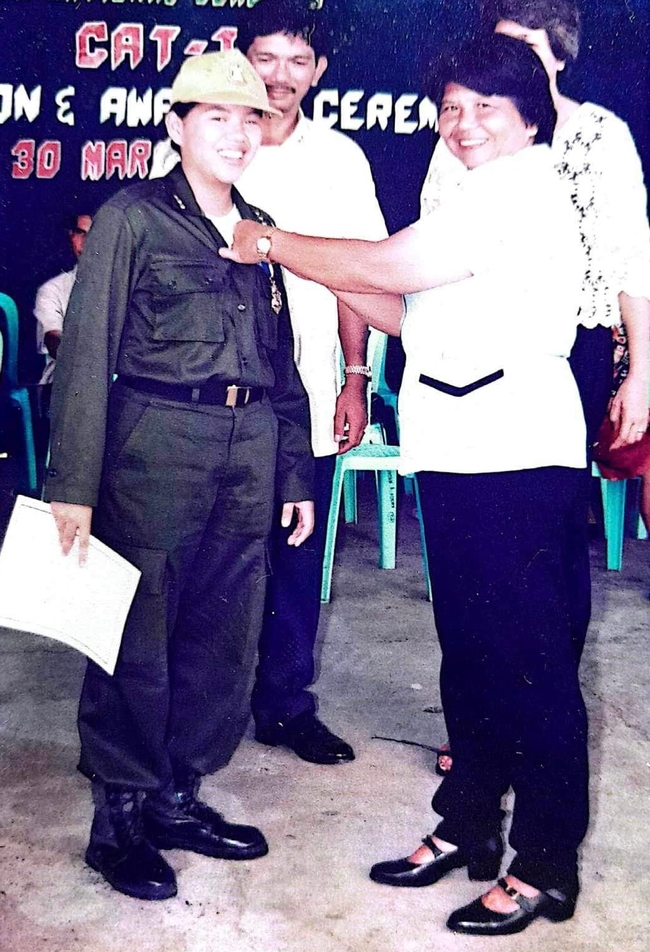- Author: Saoimanu Sope
In late April, University of California Agriculture and Natural Resources hosted its first regional meeting for UC Cooperative Extension advisors and specialists based in Southern California. The meeting, hosted by Daniel Obrist, vice provost, and Lynn Schmitt-McQuitty, director for county Cooperative Extension, brought together 50 participants over two days for networking and collaboration.
Based on feedback collected from ANR's Statewide Conference in April 2023, academics indicated a desire to meet more frequently opposed to waiting for the conference that occurs every five years. As a result, ANR is hosting regional meetings throughout California to provide an in-person opportunity for academics to discuss their research projects, interact with senior leadership, gain clarity related to merit and promotion, strengthen communication skills and network.
On the first day, academics had the option to attend an Impact and Outcome Writing Workshop presented by Martin Smith, Emeritus Professor of Cooperative Extension at UC Davis. The session also included an interactive segment, facilitated by Katherine Webb-Martinez, director of program planning and evaluation, and Christina Becker, program policy analyst for PPE, that broke down impact reporting into theory and application.
To end the day on a social note, attendees were invited to dinner where they could continue informal discussions and networking. During that time, academics got to interact with senior leaders, including Obrist and Schmitt-McQuitty, county and Research and Extension Center (REC) directors such as Rita Clemens for Riverside, San Bernardino and Orange counties, and Jairo Diaz of Desert REC, as well as statewide support staff like News and Information Outreach in Spanish (NOS).
“A key opportunity of these meetings is to build peer networks with colleagues and collaboration opportunities in the regions. So many of our academics are new to ANR, and the regional meetings allow us to welcome and onboard new colleagues and get to know each other,” Obrist said.
The meetings are also beneficial for those transitioning into a new academic role within ANR. Natalie Levy who currently works as a specialist for water resources at South Coast REC, participated in the meeting with her new position, soil health and organic materials management advisor, which begins June 3, in mind.
“It was helpful to have senior leadership present. I spoke to Lynn the most and she gave me good feedback about developing a new program and my research interests,” Levy said. “I also liked the session discussing merit and promotion because it gave me a framework to use as I step into a new role.”
The morning of the second day, academics participated in a poster session to share their research with colleagues. Attendees also engaged in discussions to understand and address regional needs, build new partnerships and engage senior leadership for support.
“I learned a lot about my colleagues from the poster session. I felt more connected to their work because I could visualize how we can collaborate,” said Ashley Hooper, urban community resiliency advisor for Los Angeles County. “It can be isolating for advisors who don't have counterparts in other counties or in ANR. Seeing how others are managing their programs during the poster session gave me reassurance that I'm on the right track in my position.”
In the afternoon, academics heard from Vice President Glenda Humiston, who addressed ANR's budget and career pathways for academics. Niamh Quinn, human-wildlife interactions advisor for Los Angeles, Orange and San Diego counties, presented on the merit and promotion process to remind academics that “swallowing the eBook” (Guidelines for UC ANR Academics Preparing the Thematic Program Review Dossier) is the best way to learn how merit and promotions work within ANR.
Finally, Saoimanu Sope, digital communications specialist, showed academics how to leverage social media as an extension tool. Ricardo Vela, program manager for News and Information Outreach in Spanish, and Miguel Sanchez, broadcast communications specialist for NOS, described how to produce videos using a smartphone.
“It was useful to see colleagues from other counties, especially those who work in different disciplines,” said Quinn, who, like Hooper, is programmatically isolated given her program niche. As someone who uses social media for her program, Quinn described the social media presentation as informative. “I felt better educated and equipped to make improvements afterwards,” she said.
The regional meeting schedule is as follows:
Region 3: May 30-31, at UCCE San Joaquin County Building in Stockton
- Counties: San Joaquin, Stanislaus, Merced, Mariposa, Mono, Inyo, Madera, Fresno, Tulare, Kings and Kern
- RECs: Kearney, Westside and Lindcove
Region 5: June 10-11, at UC Santa Cruz
- Counties: Sonoma, Napa, Marin, Contra Costa, San Francisco, San Mateo, Alameda, Santa Clara, Santa Cruz, San Benito and Monterey
Region 2: Sept. 12-13, Central/Northern Sierras, specific location TBD
- Counties: Tehama, Glenn, Butte, Colusa, Sutter, Yuba, Nevada, Placer, El Dorado, Yolo, Solano, Sacramento, Amador, Calaveras and Tuolumne
- REC: Sierra Foothills
Region 1: Feb. 26-27, 2025, Redding, specific location TBD
- Counties: Del Norte, Siskiyou, Modoc, Humboldt, Trinity, Shasta, Lassen, Mendocino, Lake and Plumas-Sierra
- RECs: Intermountain and Hopland
- Author: Anne Schellman
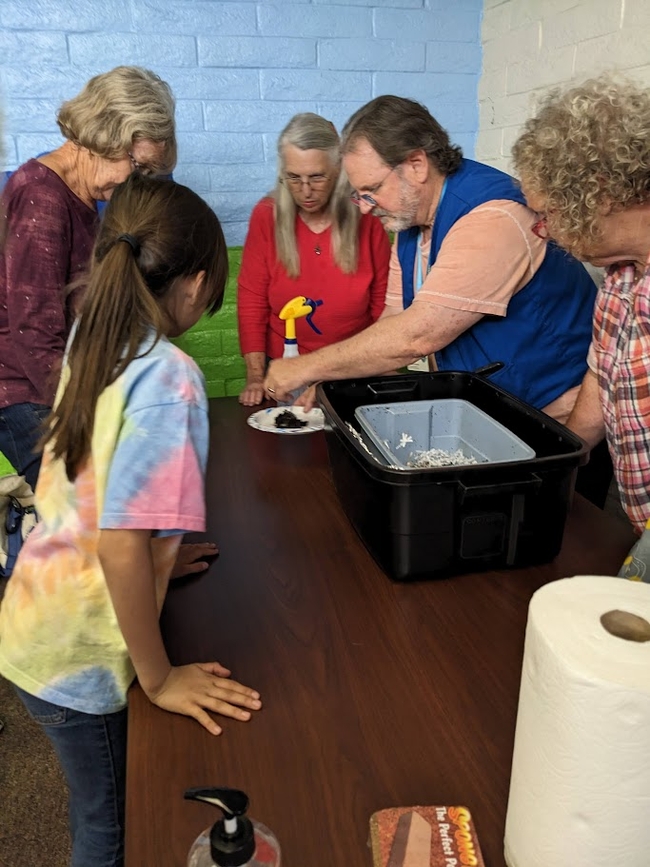 Giving Day is next week!
Giving Day is next week!

Has our program made a difference in your life? If you've attended one of our classes at a local library or garden club, gained information from reading a Sprout article, or asked a question of our Help Line, please consider making a donation to our program.
All dollars given go directly to our local program UC Cooperative Extension* Master Gardener Program in Stanislaus County.
We rely on donors like you to help us purchase much needed materials for our demonstration gardens, training classes and outreach events. They also support scholarships for individuals that cannot pay to attend training classes or workshops.
Your generosity helps us continue our mission of supporting Stanislaus County residents with sustainable gardening and pest management information.
Giving Day ends at noon on May 17. Stay tuned for another message with information on how to give, and follow us on Facebook and Instagram @UCMGStanislaus.
*Cooperative Extension operates under the umbrella of a larger, statewide organization called UC ANR or University of California Agriculture and Natural Resources.

- Author: Janet S Hartin
To date, over 1,800 climate-ready shade trees and tips on their planting and long-term care have been provided by UC Master Gardeners and over 20 partners to residents of low shade neighborhoods in San Bernardino and Riverside Counties through the “Trees for Tomorrow Start Today” project. Tree species given away are identified from research projects including the joint University of California/United States Forest Service (USFS) study at UC Riverside as well as from other research, local observations, and input from the green industry and academic colleagues.
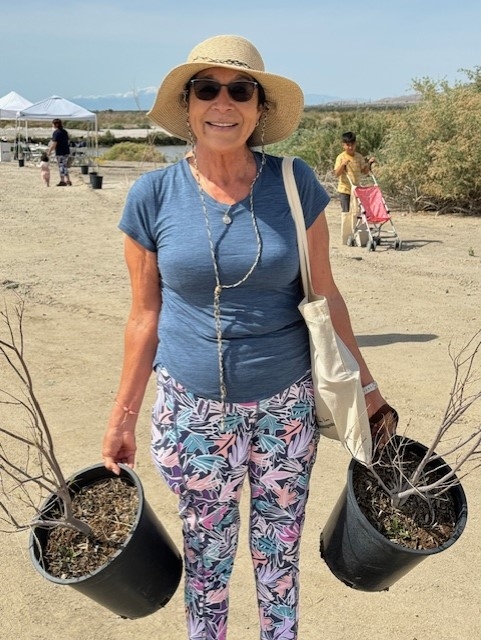
Why is this project so important? 95% of Californians now reside in cities and suburban environments. Resulting urban heat islands created by built environments coupled with impacts of climate change can be mitigated through nature-based solutions. Planting climate-ready shade trees now will help ensure cooler urban areas in the next several decades as trees mature and maximize their urban ecosystem benefits. Fortunately, the shade from a single well-placed tree can decrease surface temperatures of black asphalt and artificial turf by more than 70 degrees F in hot inland and desert cities. Studies show that surrounding air temperatures can also be reduced through the transpiration process.
A major goal of the"Trees for Tomorrow Start Today" project is to enhance tree canopy cover in low shade neighborhoods also plagued with much higher than average levels of air pollution and pulmonary and cardiovascular disease incidence. Events over the past month have occurred in Fontana, San Bernardino, and the Salton Sea.
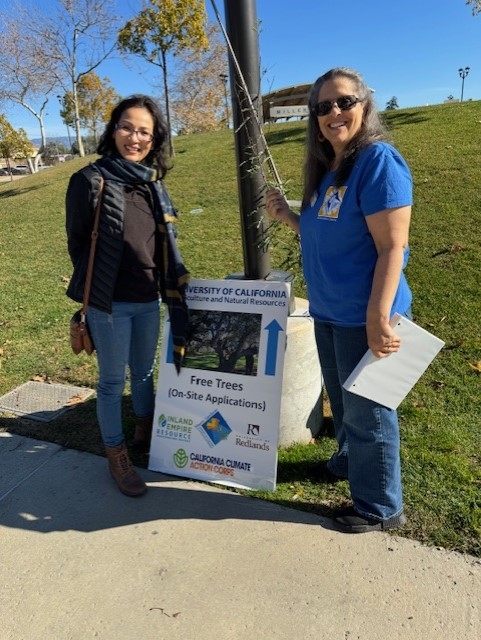
Thank you to all our partners and, especially, our tree recipients, for greening and cooling your yard and neighborhood! 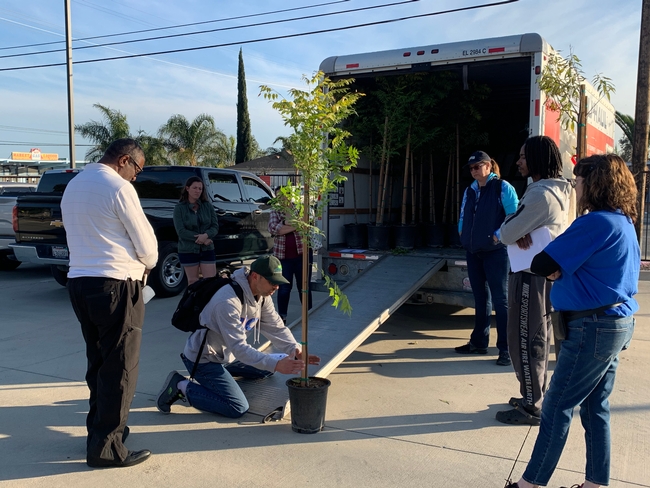
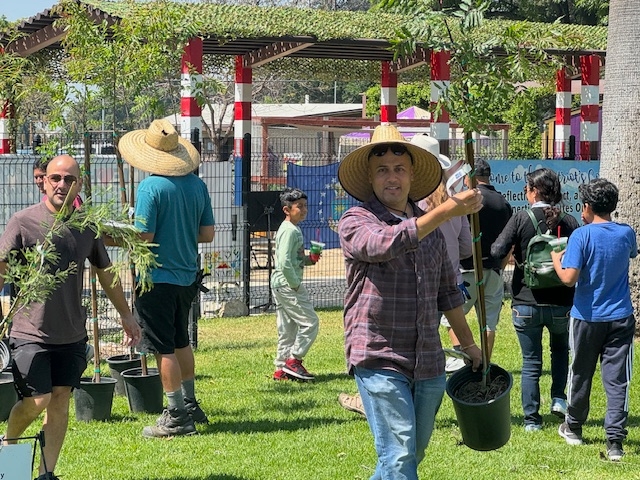
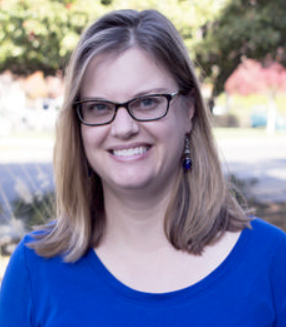
If so, please fill out this simple, two question survey found at this link: https://ucanr.edu/ucce/mg/survey
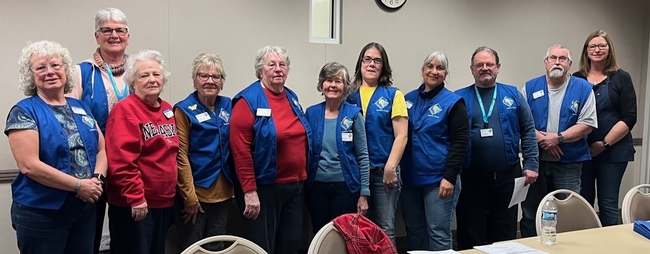
Here are the questions you'll see in the survey:
- Did you gain knowledge?
Yes No
- Will you use the information/knowledge gained? ?
- Yes, in the next 12 months.
- Probably, but not in the short term.
- No, not at all.
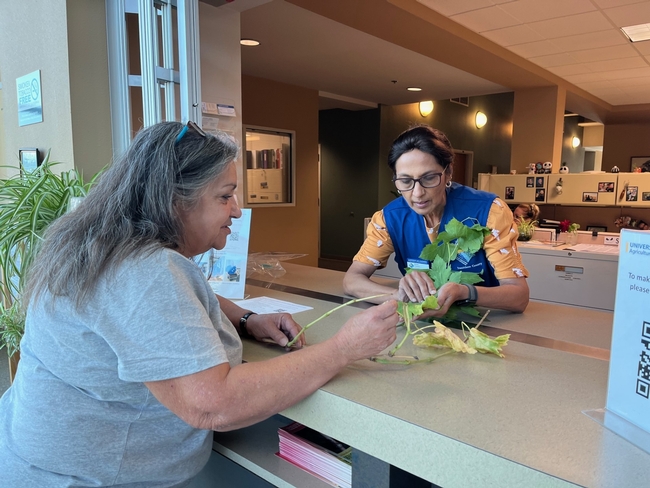
Survey Collection
We are collecting data all year long, so you only need to answer these questions once. We truly appreciate the time you take to give feedback to our program. It helps us demonstrate our value to the community by measuring our impact.
Please take a moment and fill out the survey https://ucanr.edu/ucce/mg/survey
Thank you!
Anne Schellman
UC Cooperative Extension Master Gardener Coordinator,
Stanislaus County
*Three months after you attend one of our classes, you receive an email survey with questions about the class topic. Its purpose is to find out how much you've learned and apply the information in your home garden, and is not related to the survey above.
- Author: Michael Hsu
Community nutrition and health advisor builds bridges across cultures in Tulare, Kings, Fresno and Madera counties
At a young age, Irene Padasas – UC Cooperative Extension community nutrition and health advisor for Tulare, Kings, Fresno and Madera counties – saw first-hand how environmental health conditions can impact a family's choices.
When she was in fourth grade, her parents moved their family from bustling Manila, capital of the Philippines, to a small town on a distant island. Her younger brother, who had been hospitalized at age 3 for a year due to complications from meningitis, had to re-learn how to walk and talk.
Padasas' mother hoped that leaving the more polluted urban environment would benefit his long road of rehabilitation. “The decision was made to ensure a better quality of life for my brother,” Padasas said. “So my parents decided to just move to the countryside.”
The family settled in a beach town in largely rural Aklan province, near the center of the Philippine archipelago.
“There are advantages living in a place like that, where you're close to nature; there's not much traffic; the community is very tight,” Padasas said. “You feel like you're part of this small community where everybody is looking after each other.”
Contributing to that sense of community – and cultivating close relationships to ensure the health and well-being of all – are just some of the reasons why Padasas chose her line of work in Cooperative Extension.
Padasas oversees the delivery of two federal nutrition programs in her region – CalFresh Healthy Living, University of California and the Expanded Food and Nutrition Education Program. She develops, provides and evaluates Extension programs in partnership with the diverse populations of the Central Valley, including a variety of Latino, Mexican Indigenous and Asian communities.
Despite differences in culture and background, Padasas works to find common ground and build bridges – often through a joke and a laugh.
“Humor is such a big part of Filipino culture; with the challenges that I encountered in life, humor was so important in getting through and bouncing back,” she said. “That part of my culture is an important aspect of me to build relationships and genuine connections and introduce the work that we do; they don't see us as a ‘researcher from University of California,' they see us just like them, just like anybody else in the community.”
Growing up near both the beach and farmland in Aklan, Padasas feels an affinity for the agricultural landscapes and lifestyles in the San Joaquin Valley. She remembers feeding her family's chickens and pigs and playing among the neighbors' cows and water buffalo.
“I feel like whenever I drive to different places here in the Central Valley, it reminds me a lot of my childhood back in the day,” she said.
Nevertheless, Padasas misses the food in the Philippines – especially the seafood that she grew up eating, succulent prawns and enormous fish found nowhere in California.
“We would wait by the shore for whatever the fishermen would sell – it's really fresh fish, literally fresh from the boat,” she recalled.
Mealtimes were central in the childhood of Padasas and her siblings, who both live in the Philippines and help care for their parents; her brother is an engineer and her older sister is a teacher. Food was and remains a focal point for sharing and connecting, within their household and across the culture.
“When I was growing up, my parents made sure we were spending time as a family, eating together during dinner and sharing special meals on weekends,” Padasas said.
Chance encounter leads to an Extension career
Padasas returned to the Manila metro area for college, at the University of the Philippines Dilliman, where she earned a bachelor's degree in special education. After working as a special ed teacher for about seven years, she went to graduate school at Ateneo de Manila University for her master's in developmental psychology.
Originally intending to pursue a career as a child psychologist, Padasas said her path changed when she met Maria de Guzman, a University of Nebraska professor and Ateneo de Manila alumna, who returned to her alma mater to present her research on “yayas” – live-in caregivers for children in the Philippines.
Intrigued by that study, Padasas leaped at the opportunity to pursue a Ph.D. with de Guzman at Nebraska, where she would write her doctoral dissertation on social capital – such as personal relationships and networks – as predictors of college success for underrepresented minority students.
It was also de Guzman, herself an Extension specialist, who guided Padasas on that career track.
“I knew at that time I wanted to work in Extension, but it was a vague concept to me because in the Philippines we don't have Extension as part of the university,” Padasas explained. “Dr. de Guzman was the one who really introduced me to Extension.”
During graduate school in Nebraska, Padasas gained valuable experience working with a diverse range of ethnic minorities and refugees, including Latinos, Filipinos, Yazidis and Congolese. She especially enjoyed working with children and teens – a favorite aspect of her work that continues to this day. Padasas said that, when given the opportunity to discuss her academic background, she mentions her educational experience to young people.
“I always make sure to talk about my work as a research scientist – to encourage these kids, especially those from underrepresented minority groups, to see themselves in my shoes, to show them that: ‘You could also become like me, a person of color, a researcher, and that's not an impossible path for you,'” Padasas said.
That academic track – and her entire life's journey – have prepared Padasas well for her current role, within an organization that spans the state of California and all its diverse communities.
“I think that's the beauty of the work that we do at UC ANR,” she said. “We are provided with so many opportunities to connect and to create impact for so many people across different populations.”

